
Carpenter bees are species in the genus Xylocopa of the subfamily Xylocopinae. The genus includes some 500 bees in 31 subgenera. The common name "carpenter bee" derives from their nesting behavior; nearly all species burrow into hard plant material such as dead wood or bamboo. The main exceptions are species in the subgenus Proxylocopa, which dig nesting tunnels in suitable soil.

The tribe Euglossini, in the subfamily Apinae, commonly known as orchid bees or euglossine bees, are the only group of corbiculate bees whose non-parasitic members do not all possess eusocial behavior.
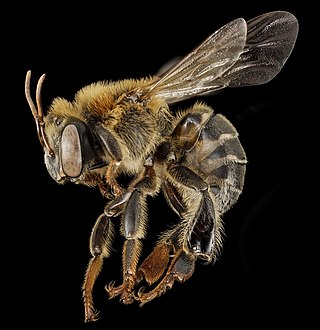
Melipona is a genus of stingless bees, widespread in warm areas of the Neotropics, from Sinaloa and Tamaulipas (México) to Tucumán and Misiones (Argentina). About 70 species are known. The largest producer of honey from Melipona bees in Mexico is in the state of Yucatán where bees are studied at an interactive park called "Bee Planet" which is within the Cuxtal Ecological Reserve.
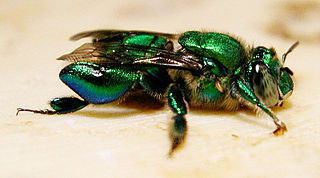
Euglossa is a genus of orchid bees (Euglossini). Like all their close relatives, they are native to the Neotropics; an introduced population exists in Florida. They are typically bright metallic blue, green, coppery, or golden.
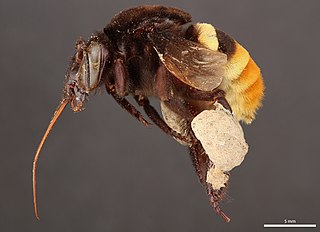
Eulaema is a genus of large-bodied euglossine bees that occur primarily in the Neotropics. They are robust brown or black bees, hairy or velvety, and often striped with yellow or orange, typically resembling bumblebees. They lack metallic coloration as occurs in the related genus Eufriesea.

Exaerete is a genus of euglossine bees found from Mexico to northern Argentina. Like all orchid bees, they are restricted to the Neotropics. All but one species is metallic green, and they are cleptoparasites in the nests of other euglossines in the genera Eufriesea and Eulaema. It contains the following species:

Aglae is a genus of euglossine bees, with the only described species Aglae caerulea. Like all orchid bees, it is restricted to the Neotropics. They are metallic blue. This species, like the genus Exaerete, is a nest parasite on free-living Euglossini. A. caerulea lays its eggs in the nests of Eulaema nigrita, and possibly other Eulaema species.
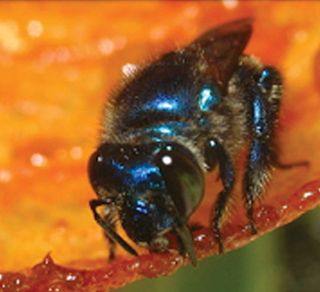
Euglossa hyacinthina, is a species of the orchid bee tribe Euglossini in the family Apidae. With a tongue that can get up to as long as 4 cm, this orchid bee species is found in Central America. Living in a neotropical climate, E.hyacinthina has adapted to hot and humid weather. The bee has darkly shaded, translucent wings and a metallic, glossy blue skeleton.
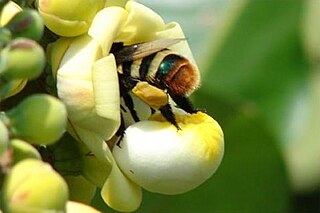
Eulaema meriana is a large-bodied bee species in the tribe Euglossini, otherwise known as the orchid bees. The species is a solitary bee and is native to tropical Central and South America. The male collects fragrances from orchid flowers, which it stores in hollows in its hind legs. Orchids can be deceptive by mimicking the form of a female and her sex pheromone, thus luring male bees or wasps. Pollination will take place as the males attempt to mate with the labellum, or the tip petal of the flower. Male E. meriana are territorial and have a particular perch on a tree trunk where it displays to attract a female. After mating, the female builds a nest with urn-shaped cells made with mud, feces, and plant resin, and provisions these with nectar and pollen before laying an egg in each. These bees also have complex foraging and wing buzzing behaviors and are part of a mimicry complex.
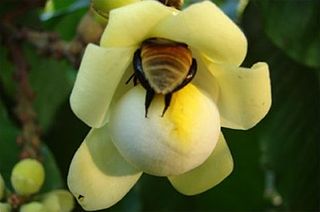
Eulaema mocsaryi is a species of large-bodied bee in the tribe Euglossini, the orchid bees. It was named in honour of the Hungarian entomologist Alexander Mocsáry, curator of the Hungarian Natural History Museum. It is native to forests in parts of tropical South America.

Exaerete smaragdina is a species of kleptoparasitic euglossine bees.
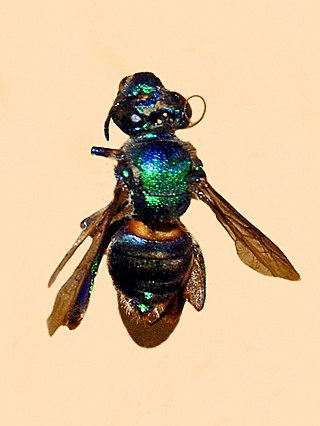
Euglossa cordata is a primitively eusocial orchid bee of the American tropics. The species is known for its green body color and ability to fly distances of over 50 km. Males mostly disperse and leave their home nests, while females have been observed to possess philopatric behavior. Because of this, sightings are rare and little is known about the species. However, it has been observed that adults who pollinate certain species of orchids will become intoxicated during the pollination.
Euglossa jacquelynae is a Euglossine bee species found in Central Brazil.

Eufriesea surinamensis belongs to the tribe of euglossine bees and as such is a species of orchid bee. This should not be mistaken with the species group surinamensis, which includes Ef. surinamensis among other Eufriesea species.

Euglossa imperialis is a bee species in the family Apidae. It is considered to be one of the most important pollinators to many Neotropical orchid species in mainland tropical America. It is also one of the most common non-parasitic euglossine species in lowland Panama. E. imperialis, unlike many other bee species, is not a social bee in the sense that there is no apparent morphological or physiological division within the species to distinguish individual bees to be part of a worker or reproductive caste.

Euglossa mixta is a species of orchid bee native to Central America and South America, it is a member of the genus Euglossa a group of brilliant green and blue bees specialized in pollinating certain species of orchids.
Paratrigona is a genus of bees belonging to the family Apidae.
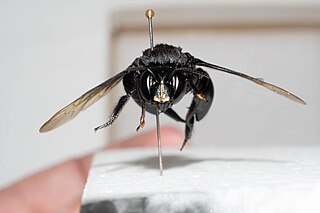
Eulaema cingulata is a large-bodied black and orange corbiculate bee in the genus Eulaema. It is characterized by its size and flashy orange segments of its metastoma. Unlike other Eulaema, E. cingulata has white markings on its face. Specifically, T1 andT3 are black while T2 and T4 through T7 are cream or slightly orange in color. These bees are easily mistaken for bumblebees . However, they are actually members of the Euglossini, or orchid bees.

Eufriesea purpurata is a species of eusocial orchid bee common in northeastern South America, particularly in the Amazon basin. It is an important pollinator of various wild plants, and it is noted for its attraction to various synthetic compounds used by humans, including some insecticides. In the late 1970s, males of the species pestered an indigenous Amazonian community whose palm-leaf houses had been sprayed by the government with DDT, which the bees found attractive.


















